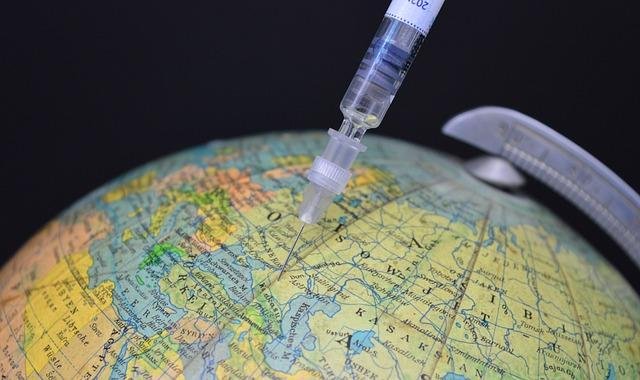In a world forever changed by the relentless march of infectious diseases, vaccines have emerged as humanity’s steadfast allies—tiny vials of protection promising to shield millions. Yet, as we navigate the complex landscape of global health, the story of vaccination is no simple tale of triumph. From bustling urban clinics in developed nations to remote rural outposts in lower-income regions, the patterns of vaccine uptake trace a mosaic of hope, hesitation, disparity, and challenge. This article delves into the evolving global vaccination trends and the concerns that accompany them, exploring how science, society, and policy converge in the ongoing quest to safeguard public health.
Table of Contents
- Global Patterns Shaping Vaccination Coverage Across Continents
- Understanding Socioeconomic Barriers to Immunization Access
- Addressing Vaccine Hesitancy Through Community Engagement
- The Role of Technology in Enhancing Vaccine Distribution
- Evaluating Policy Frameworks for Equitable Vaccine Allocation
- Strategic Recommendations for Sustainable Global Immunization Efforts
- Q&A
- To Conclude

Global Patterns Shaping Vaccination Coverage Across Continents
Across the globe, vaccination coverage reflects a complex interplay of socio-economic factors, healthcare infrastructure, and cultural perceptions. In continents like Europe and North America, robust public health systems and widespread awareness campaigns have propelled immunization rates to high levels, often exceeding 90% for childhood vaccines. Contrastingly, regions in Africa and parts of Asia face challenges such as limited access to healthcare facilities, vaccine hesitancy fueled by misinformation, and logistical barriers in rural or conflict-affected areas. These disparities highlight the urgency for tailored approaches that not only ensure vaccine availability but also foster trust within communities.
Examining vaccination patterns through a regional lens reveals distinct trends that inform global strategies. For instance, Latin America shows significant progress due to strong governmental initiatives and international partnerships, yet pockets of under-immunization persist. Meanwhile, Oceania grapples with geographic isolation, impacting vaccine distribution despite high willingness to vaccinate. The following table summarizes vaccination coverage rates for selected continents, underscoring these varied realities:
| Continent | Average Childhood Vaccination Rate | Primary Challenges |
|---|---|---|
| Europe | 92% | Vaccine Hesitancy in Urban Areas |
| Africa | 65% | Healthcare Access, Infrastructure |
| Asia | 78% | Rural Reach, Cultural Beliefs |
| Latin America | 85% | Economic Disparities |
| Oceania | 80% | Geographical Barriers |

Understanding Socioeconomic Barriers to Immunization Access
Barriers rooted in socioeconomic factors play a pivotal role in shaping access to immunization services globally. Limited income, educational disparities, and geographic isolation often create a web of challenges that hinder timely vaccination. For many communities, the cost of travel, lack of reliable healthcare infrastructure, and insufficient awareness are not just minor obstacles but significant barriers that prevent individuals, especially children, from receiving essential vaccines. These hurdles contribute to uneven immunization coverage, perpetuating cycles of vulnerability and disease outbreaks in areas where healthcare access is already scarce.
- Income inequality: High costs related to healthcare visits or indirect expenses can discourage routine immunizations.
- Educational gaps: Lack of vaccine literacy often results in mistrust or misinformation about immunization benefits and safety.
- Geographical isolation: Remote or rural areas face fewer healthcare facilities and longer travel times to clinics.
To better illustrate the disparities, consider the table below showcasing vaccination rates relative to income brackets in hypothetical regions:
| Income Level | Vaccination Coverage (%) | Primary Barrier |
|---|---|---|
| Low | 45 | Travel Costs |
| Middle | 72 | Awareness |
| High | 90 | Minimal |
Addressing these socioeconomic dimensions is essential for crafting targeted policies and interventions. Bridging gaps through community engagement, education, and subsidized healthcare access can transform immunization landscapes and safeguard populations against preventable diseases.

Addressing Vaccine Hesitancy Through Community Engagement
Building trust remains paramount in overcoming doubts about vaccinations. Empowering local voices through community-led initiatives fosters a sense of ownership and credibility. Beyond just facts, these programs emphasize storytelling, where personal experiences and cultural narratives resonate more deeply than statistics alone. Partnering with trusted community figures like religious leaders, teachers, and influencers helps dismantle fears, creating a ripple effect of positive perception and acceptance.
Effective engagement requires addressing diverse concerns with tailored approaches. Strategies include:
- Interactive workshops that encourage open dialogue and questions.
- Multilingual resources reflecting local languages and dialects.
- Mobile clinics to increase accessibility in underserved areas.
| Engagement Method | Key Benefit | Example |
|---|---|---|
| Community Storytelling Circles | Build emotional connection | Local vaccine recipients share experiences |
| Cultural Festivals | Celebrate diversity & health | Vaccine information booths at events |
| Peer-led Education | Trust via relatable sources | Youth ambassadors in schools |

The Role of Technology in Enhancing Vaccine Distribution
In recent years, the integration of cutting-edge technology has revolutionized the logistics and management of vaccine distribution on a global scale. From the use of blockchain to enhance transparency and reduce fraud, to AI-driven predictive models that forecast demand surges, technology ensures vaccines reach even the most remote and underserved communities efficiently. Cold chain monitoring systems, powered by IoT sensors, maintain optimal temperature conditions throughout the supply process, drastically cutting down spoilage rates and ensuring vaccine efficacy upon administration.
- Real-time tracking: GPS-enabled shipments provide instant updates, allowing stakeholders to adjust routes dynamically.
- Automated inventory management: AI algorithms prevent stockouts and surplus by synchronizing supply with vaccination schedules.
- Mobile health platforms: These enable appointment scheduling and send reminders, reducing missed vaccinations.
| Technology | Impact | Example Use Case |
|---|---|---|
| Blockchain | Enhanced transparency & anti-counterfeiting | Verifying authentic vaccine batches |
| IoT Sensors | Cold chain integrity | Temperature tracking during transport |
| Artificial Intelligence | Demand prediction & route optimization | Forecasting regional needs in real time |

Evaluating Policy Frameworks for Equitable Vaccine Allocation
When dissecting the frameworks designed to distribute vaccines fairly, one must consider both the ethical imperatives and practical constraints that shape these policies. Models based on prioritizing vulnerable populations, such as the elderly and frontline workers, reflect a commitment to reducing mortality and maintaining societal functions. However, the implementation of these frameworks varies widely, influenced by economic capacities, healthcare infrastructure, and political will. As a result, policies that look equitable on paper may face significant hurdles in real-world application, highlighting the complexities behind vaccine equity.
Several key factors emerge as consistent pillars in successful allocation strategies:
- Transparency: Clear communication of prioritization criteria builds public trust and compliance.
- Adaptability: Agile policies that respond to emerging data on vaccine efficacy and virus variants.
- Inclusivity: Engaging diverse community leaders to address cultural and logistical barriers.
| Policy Attribute | Impact on Equity |
|---|---|
| Targeted Outreach Programs | Medium |
| Global Dose Sharing Initiatives | High |
| Age-based Prioritization | Moderate |
Equitable vaccine allocation transcends simple distribution logistics; it requires systemic reflection on global inequalities and proactive measures to bridge them. While policy frameworks lay the foundation, their effectiveness is ultimately measured by the balance between accessibility and fairness in protecting all communities, especially those historically marginalized or underserved.

Strategic Recommendations for Sustainable Global Immunization Efforts
To ensure long-term success in global immunization, collaborative frameworks between governments, non-profits, and private sectors must be prioritized. Investing in robust healthcare infrastructure remains critical, with an emphasis on cold chain logistics to maintain vaccine potency. Additionally, integrating digital health technologies can streamline vaccine tracking and data collection, making immunization campaigns more efficient and transparent. Public trust is another cornerstone; transparent communication strategies and community engagement, especially in regions with vaccine hesitancy, are essential for widespread acceptance.
- Strengthen cross-border coordination to address disparities in vaccine access
- Expand funding for research on emerging infectious diseases and vaccine development
- Deploy targeted education programs to dispel myths and misinformation
- Leverage mobile health units to reach remote populations
| Focus Area | Key Action | Expected Outcome |
|---|---|---|
| Infrastructure | Upgrade storage & transport systems | Preserved vaccine efficacy |
| Technology | Implement digital immunization records | Improved data accuracy & access |
| Community | Engage local influencers | Higher vaccination rates |
Q&A
Q&A: Understanding
Q1: What are the current global trends in vaccination rates?
A1: Globally, vaccination rates have seen a mix of progress and setbacks. While many countries have expanded immunization programs, reaching more children and adults than ever, others face challenges like supply shortages, logistical hurdles, and vaccine hesitancy. Overall, there is a steady increase in coverage for traditional vaccines, but newer immunizations—such as those for COVID-19—show uneven adoption across regions.
Q2: Which vaccines are currently prioritized worldwide?
A2: The focus remains on childhood immunizations like measles, polio, and diphtheria-tetanus-pertussis (DTP). However, COVID-19 vaccination campaigns have become a global priority, alongside efforts to boost influenza and HPV vaccine coverage. Emerging diseases and seasonal outbreaks also influence which vaccines receive heightened attention.
Q3: What are the main challenges impacting global vaccination efforts?
A3: Key obstacles include vaccine accessibility in low-resource areas, misinformation fueling vaccine hesitancy, political and social instability disrupting health services, and inequities in vaccine distribution. Logistics, such as cold chain requirements and healthcare infrastructure, further complicate efforts.
Q4: How does vaccine hesitancy affect global health?
A4: Vaccine hesitancy—the reluctance or refusal to vaccinate despite availability—poses a significant threat by reducing herd immunity, enabling preventable diseases to resurface. This phenomenon is driven by mistrust, misinformation, cultural beliefs, and fear, undermining public health campaigns and prolonging outbreaks.
Q5: What steps are being taken to improve global vaccination coverage?
A5: Organizations like WHO, UNICEF, and Gavi lead initiatives to fund vaccine delivery, strengthen healthcare systems, and combat misinformation. Tailored community engagement, mobile clinics, and education campaigns aim to build trust. Innovative technologies and partnerships also seek to make vaccines more accessible and affordable.
Q6: Are new vaccine technologies influencing global trends?
A6: Absolutely. mRNA technology, viral vectors, and other novel platforms accelerate vaccine development and adaptability, as seen with COVID-19 vaccines. These innovations promise faster responses to emerging diseases and potentially more effective immunizations, reshaping the global vaccination landscape.
Q7: How might future global vaccination efforts evolve?
A7: Future efforts are likely to emphasize equity, combining scientific advances with culturally sensitive communication and stronger health infrastructure. Digital tools may improve tracking and delivery, while global collaboration will be critical to addressing pandemics and persistent infectious diseases alike.
This Q&A aims to illuminate the complex, dynamic world of global vaccination — a vital cornerstone of public health—highlighting ongoing achievements and the challenges still to be overcome.
To Conclude
As the world continues to navigate the complex landscape of immunization, global vaccination trends serve as both a mirror and a map—reflecting our shared vulnerabilities and guiding us toward collective resilience. While challenges persist, from logistical hurdles to deep-seated hesitations, the ongoing pursuit of widespread vaccine coverage remains a testament to human ingenuity and cooperation. In understanding these trends and concerns, we not only chart the progress made but also illuminate the path ahead, reminding us that in the quest for health security, no nation is an island, and every shot counts.














Leave feedback about this